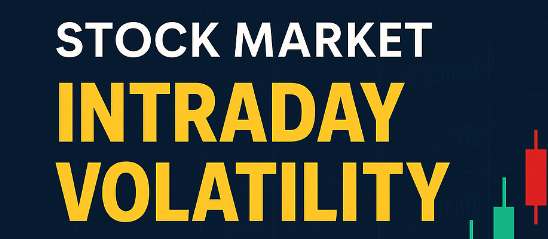- Sector -2, B Block Noida-201301
- info@tradingshastra.com
Stock Market — Intraday Volatility: 5 Proven Strategies Traders Use Today
Intraday trading is fast, thrilling, and unpredictable — but nothing tests a trader’s skill more than sudden volatility spikes.
One minute the market is calm, and the next, Nifty moves 100 points in two candles.
Every trader has faced that moment:
Stop-loss hits, positions reverse, and emotions take over.
But smart traders — the kind we train at Trading Shastra Academy — don’t fear volatility. They use it as an opportunity.

What Is Intraday Volatility?
Volatility simply measures how fast and how far prices move within a given period.
In intraday terms, it’s how much a stock or index fluctuates within market hours.
You can think of volatility like waves in the ocean:
Low volatility: Calm sea — range-bound, quiet trades.
High volatility: Rough sea — fast swings, bigger profits or faster losses.
In India, volatility spikes often happen during:
Global cues (US Fed statements, oil moves, geopolitical news)
F&O expiry sessions (especially Thursdays)
Major data releases (CPI, RBI policy, corporate results)
Sudden large-cap stock news (Reliance, HDFC Bank, Infosys, etc.)
Why Volatility Matters for Day Traders
Volatility isn’t bad — it’s the fuel that powers intraday profits. Without it, prices don’t move enough to make meaningful trades.
However, the challenge is managing unpredictability.
In a volatile session, stop-loss hunting, whipsaws, and false breakouts become common.
That’s why you need clear, structured volatility strategies — not emotions.
Key Indicators to Track Volatility
Before jumping into strategies, you must first detect volatility.
Here are the tools that experienced traders rely on:
India VIX: The official volatility index of NSE.
When VIX > 15 → expect larger intraday ranges.
When VIX < 11 → markets likely to stay range-bound.
ATR (Average True Range): Measures average candle size.
Higher ATR = more price movement.
Ideal for setting dynamic stop-loss and targets.
Bollinger Bands: Expand when volatility rises and contract when it falls.
A sudden band expansion signals breakout strength.
Band contraction (squeeze) hints at possible upcoming volatility.
VWAP (Volume Weighted Average Price):
Helps you identify real momentum zones during high volume moves.
News / Data Alerts: Always track real-time triggers — RBI updates, earnings, or global cues.
5 Proven Strategies to Handle Intraday Volatility
Let’s get to the practical part — the five battle-tested volatility strategies every trader should know and master.
1. The Volatility Breakout Strategy
When volatility spikes, price often breaks out of key ranges or previous highs/lows.
How to trade it:
Mark previous day’s high and low.
Wait for a clean breakout with volume confirmation.
Use ATR to calculate stop-loss — usually 0.8×ATR below breakout candle.
Book partial profits quickly; trail rest with VWAP or EMA.
Example (last 24h):
Bank Nifty broke above its previous high around 49,000 after a flat open. Traders who entered with ATR-based stops captured a 150-point surge in 20 minutes.
Pro tip:
Avoid chasing breakouts during the first 5 minutes of market open — let volatility settle first.
2. The Mean Reversion Scalping Strategy
In high volatility, prices often overshoot due to panic buying/selling — then snap back.
How to trade it:
Use Bollinger Bands on a 5-minute chart.
When candles close outside the band, wait for re-entry confirmation (close back inside).
Enter opposite side trade (short when it re-enters from upper band, long from lower).
Target 0.5×ATR, stop-loss just beyond recent wick.
Why it works:
It leverages trader emotion — volatility pushes extremes, and scalpers profit from snapbacks.
When to avoid:
Strong trending days (check ADX > 25) — avoid mean reversion in one-directional markets.
3. The Volatility-Based Stop-Loss System
The biggest mistake new traders make?
Using fixed-point stop losses (like ₹2 or ₹5).
Volatile markets don’t respect fixed points — they demand adaptive stops.
How to set smarter stops:
Use ATR (Average True Range) of the timeframe you trade.
Example: If 5-min ATR = ₹4, then ideal stop = 1.2 × ATR = ₹4.8.
It’s logical because it adapts to current market energy.
Bonus tip:
Never risk more than 1%–2% of your capital per trade.
Volatility can expand fast — you want to survive, not impress.
4. The Multi-Timeframe Confirmation Strategy
Volatile sessions often trap traders by showing false breakouts on smaller charts. To counter that, combine multi-timeframe confluence.
How to trade it:
Mark major levels on 15-minute and hourly charts.
Execute entries on the 5-minute chart only when higher timeframe confirms trend direction.
If both align (e.g., 15-min uptrend + 5-min bullish breakout), your probability improves.
Example:
In today’s session, Nifty futures gave a breakout on 5-min chart, but hourly chart resistance was nearby — traders who ignored it saw reversal whipsaws.
Multi-timeframe view filters fake volatility moves.
5. The Risk-Managed Position Sizing Strategy
Even the best strategy fails if your size is wrong.
During high volatility, smart traders cut position size — not increase it.
Rules to follow:
As ATR or VIX rises, reduce your trade size proportionally.
e.g., if volatility doubles, cut position by half.
Avoid over-leveraging intraday — use lower margin exposure when candles expand.
Always have a daily max-loss limit (like 2%–3% of capital).
If hit, shut terminal. No revenge trades.
Example:
If your normal Nifty lot is 2 when ATR = 80,
trade only 1 lot when ATR jumps to 160.
This simple adjustment can protect weeks of profit in one wild session.
Bonus: How to Read Volatility Patterns
Here’s a simple pattern recognition framework we teach in the Supreme Trader Program:
| Volatility Pattern | What It Means | Best Action |
|---|---|---|
| Morning Spike, Midday Drop | News reaction fades | Fade extremes, scalp reversals |
| Slow Range Expansion | Institutional entry building | Trade breakout with volume |
| Sudden Candle Burst | Algo-driven move | Avoid entry, wait for confirmation |
| Multiple Wick Rejections | Mixed sentiment, indecision | Use smaller stops, take partials |
Understanding context of volatility is as important as the setup itself.
Trading Psychology During Volatility
No matter how perfect your setup, volatility will test your emotions.
Tips from our mentors:
Accept that you won’t catch every move.
Focus on process consistency, not daily profit.
Journal your volatile-day trades — see if emotions led or rules did.
Reward yourself for discipline, not just green P&L.
Remember:
Volatility exposes overconfidence faster than it rewards skill. Patience is your true edge.
When to Avoid Trading Volatility
Even pros know when to sit out.
Avoid trading when:
India VIX spikes beyond 18 (too wild).
Global markets are jittery post big news events.
You’ve had 2 consecutive losing trades — emotions distort logic.
There’s overlapping data (e.g., F&O expiry + RBI policy day).
Sometimes the best trade is no trade — and that’s perfectly okay.
Quick Recap — The 5 Proven Volatility Strategies
| # | Strategy | Core Idea | Works Best When |
|---|---|---|---|
| 1 | Volatility Breakout | Ride price expansion | Post-consolidation moves |
| 2 | Mean Reversion Scalping | Fade over-extensions | Range-bound volatility |
| 3 | ATR Stop-Loss System | Dynamic risk control | Trending & volatile days |
| 4 | Multi-Timeframe Confirmation | Filter false breakouts | Choppy volatility |
| 5 | Risk-Managed Position Sizing | Control exposure | High VIX sessions |
Use them together — not in isolation.
That’s how consistency is built.
Final Thoughts from Trading Shastra Academy
Intraday volatility is inevitable — but unpredictable doesn’t mean unmanageable.
With structured methods, rule-based entries, and emotional control, volatility can become your greatest ally.
If you’re serious about mastering real-market volatility,
our Supreme Trader Program and Ultra Supreme Trader Program are designed precisely for that — combining live-market exposure, risk-adjusted strategy building, and mentorship under Himanshu Gurha.
Key Takeaways
Volatility = opportunity + risk. Treat both equally.
Use India VIX, ATR, and Bollinger Bands as volatility compass.
Replace fixed stops with volatility-based dynamic stops.
Reduce size when volatility rises — not increase it.
Let patience, not panic, drive your trades.
Disclaimer
This blog is for educational purposes only. Stock market investments are subject to risks. Please do thorough research before trading or investing.
Written by:
Trading Shastra Academy Team
Founded by Himanshu Gurha.

